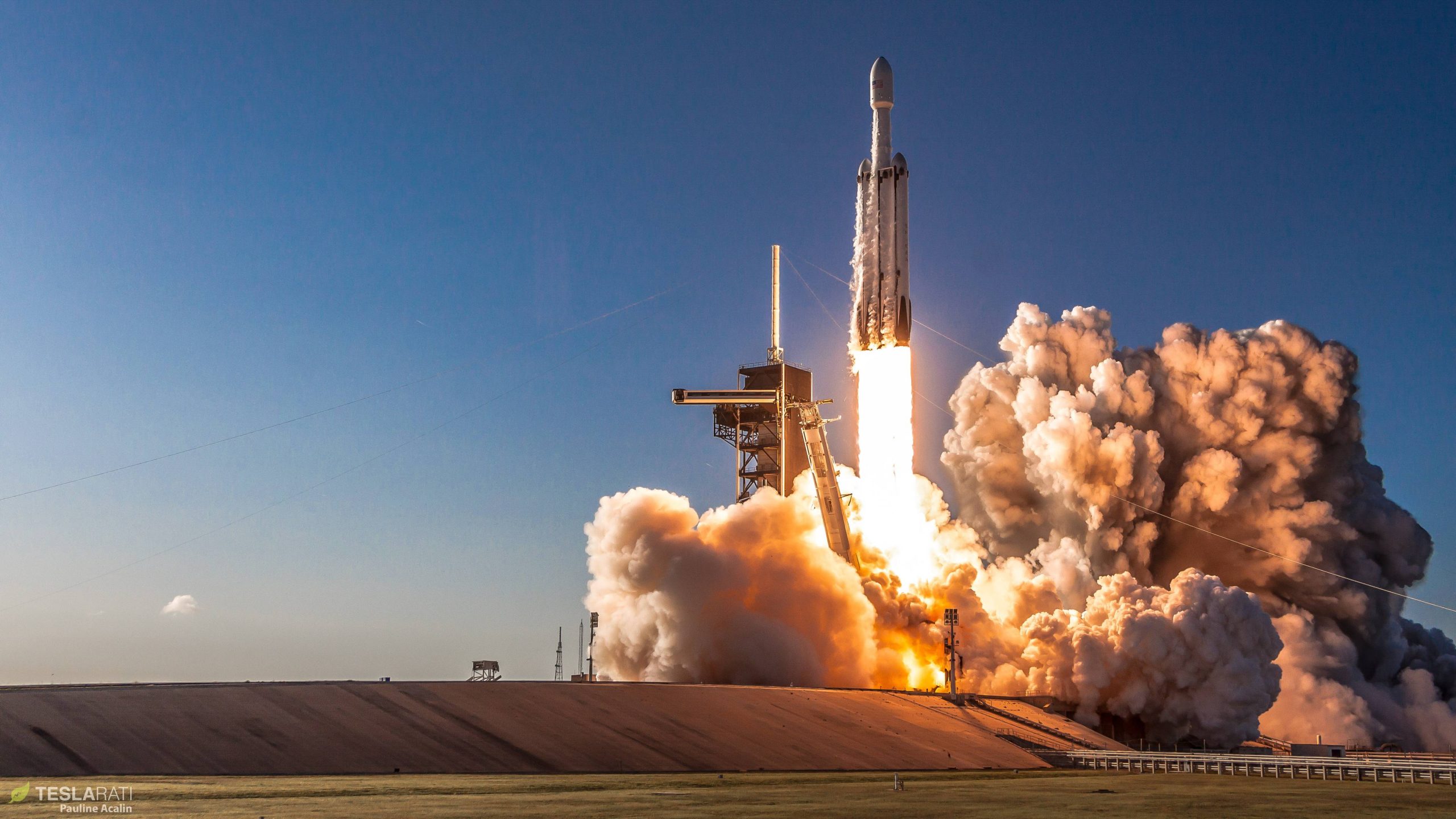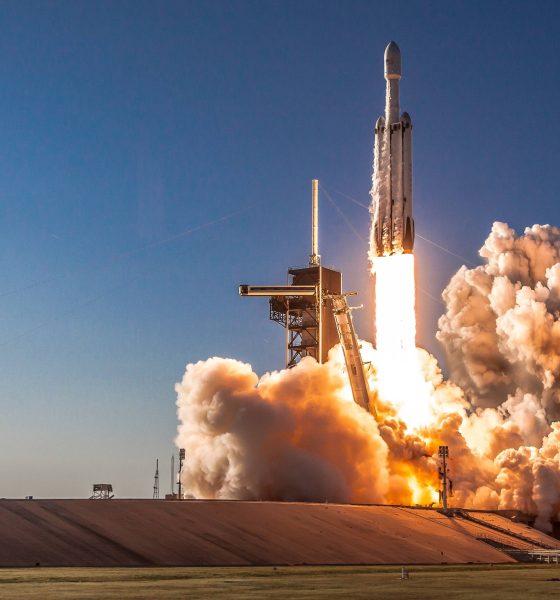

News
SpaceX set for third Falcon Heavy launch: here’s how to watch live
SpaceX is T-18 hours to its second Falcon Heavy launch in barely 70 days, set to lift off with the Department of Defense’s Space Test Program-2 (STP-2) rideshare mission no earlier than (NET) 11:30 pm EDT (03:30 UTC), June 24th.
According to SpaceX CEO Elon Musk, STP-2 is without a doubt the company’s “most difficult launch ever”, owing to a multitude of high-stakes performance requirements, US military and NASA oversight, several technical milestones, challenging booster and fairing recoveries, and much, much more. Should SpaceX succeed on all fronts, the company will have taken a massive leap towards being able to offer competitive launch services that can fulfill all of the US government’s many different spaceflight needs.
Prelaunch Appetizers ???
- SpaceX set for Falcon Heavy triple booster landing, hottest center core reentry yet
- SpaceX ship Mr. Steven renamed, departs for first Falcon Heavy fairing catch attempt in 7 months
Challenges all the way down
Likely the single most challenging aspect of STP-2 is the performance the mission’s Falcon 9 upper stage will have to deliver. SpaceX describes the challenge below:
“[The STP-2 mission] will deliver 24 satellites to space on the DoD’s first-ever SpaceX Falcon Heavy launch. [It] will be among the most challenging launches in SpaceX history, with four separate upper-stage engine burns, three separate deployment orbits, a final propulsive passivation maneuver, and a total mission duration of over six hours.”
— SpaceX.com/STP-2
According to older USAF documents (STP-2’s original launch target was mid-2015), those numbers could actually rise as high as five separate upper-stage Merlin Vacuum burns and a mission duration of more than 7.5 hours. Given the last-second decision to move Falcon Heavy’s center core recovery from ~40 km offshore to more than 1240 km offshore, it’s fairly likely that five burns and 7.5 hours will be closer to the reality of STP-2. In short, the center core will move from a gentle recovery to what will probably be SpaceX’s hottest and hardest booster recovery ever to transfer as much margin as possible to STP-2’s upper stage.


With regard to that extra spicy reentry, Falcon Heavy center core B1057 – the second Block 5 center core built by SpaceX – is now expected to attempt a landing aboard drone ship Of Course I Still Love You (OCISLY) more than 1240 km (770 mi) off the coast of Florida, potentially smashing the current record of ~970 km (600 mi).
At the same time, fairing recovery vessel GO Ms. Tree (formerly Mr. Steven; renamed due to change in ownership) is steaming hard, heading anywhere from 1400-1600 km into the Atlantic Ocean. Falcon Heavy STP-2 will be the vessel’s first attempted fairing catch since December 3rd, 2018, nearly seven months ago. It will likely crush the previous record for most distant fairing recovery attempt by 50% or more. Whether or not the vessel succeeds and catches its first Falcon fairing(s) ever, it’s exciting to see Ms. Tree (Mr. Steven) out and about for a fairing recovery after months of inactivity.

As always, SpaceX will host an official Falcon Heavy STP-2 livestream, beginning around T-15 minutes and likely lasting at least 1-2 hours as the rocket’s upper stage prepares for a ~7.5-hour orbital marathon.
Want to remember the awesomeness of Falcon Heavy every single day? Consider a limited-edition set of high-quality prints, signed by both Teslarati photographers to commemorate the rocket’s inaugural Starman launch.

News
Tesla FSD fleet is nearing 7 billion total miles, including 2.5 billion city miles
As can be seen on Tesla’s official FSD webpage, vehicles equipped with the system have now navigated over 6.99 billion miles.

Tesla’s Full Self-Driving (Supervised) fleet is closing in on almost 7 billion total miles driven, as per data posted by the company on its official FSD webpage.
These figures hint at the massive scale of data fueling Tesla’s rapid FSD improvements, which have been quite notable as of late.
FSD mileage milestones
As can be seen on Tesla’s official FSD webpage, vehicles equipped with the system have now navigated over 6.99 billion miles. Tesla owner and avid FSD tester Whole Mars Catalog also shared a screenshot indicating that from the nearly 7 billion miles traveled by the FSD fleet, more than 2.5 billion miles were driven inside cities.
City miles are particularly valuable for complex urban scenarios like unprotected turns, pedestrian interactions, and traffic lights. This is also the difference-maker for FSD, as only complex solutions, such as Waymo’s self-driving taxis, operate similarly on inner-city streets. And even then, incidents such as the San Francisco blackouts have proven challenging for sensor-rich vehicles like Waymos.
Tesla’s data edge
Tesla has a number of advantages in the autonomous vehicle sector, one of which is the size of its fleet and the number of vehicles training FSD on real-world roads. Tesla’s nearly 7 billion FSD miles then allow the company to roll out updates that make its vehicles behave like they are being driven by experienced drivers, even if they are operating on their own.
So notable are Tesla’s improvements to FSD that NVIDIA Director of Robotics Jim Fan, after experiencing FSD v14, noted that the system is the first AI that passes what he described as a “Physical Turing Test.”
“Despite knowing exactly how robot learning works, I still find it magical watching the steering wheel turn by itself. First it feels surreal, next it becomes routine. Then, like the smartphone, taking it away actively hurts. This is how humanity gets rewired and glued to god-like technologies,” Fan wrote in a post on X.
News
Tesla starts showing how FSD will change lives in Europe
Local officials tested the system on narrow country roads and were impressed by FSD’s smooth, human-like driving, with some calling the service a game-changer for everyday life in areas that are far from urban centers.

Tesla has launched Europe’s first public shuttle service using Full Self-Driving (Supervised) in the rural Eifelkreis Bitburg-Prüm region of Germany, demonstrating how the technology can restore independence and mobility for people who struggle with limited transport options.
Local officials tested the system on narrow country roads and were impressed by FSD’s smooth, human-like driving, with some calling the service a game-changer for everyday life in areas that are far from urban centers.
Officials see real impact on rural residents
Arzfeld Mayor Johannes Kuhl and District Administrator Andreas Kruppert personally tested the Tesla shuttle service. This allowed them to see just how well FSD navigated winding lanes and rural roads confidently. Kruppert said, “Autonomous driving sounds like science fiction to many, but we simply see here that it works totally well in rural regions too.” Kuhl, for his part, also noted that FSD “feels like a very experienced driver.”
The pilot complements the area’s “Citizen Bus” program, which provides on-demand rides for elderly residents who can no longer drive themselves. Tesla Europe shared a video of a demonstration of the service, highlighting how FSD gives people their freedom back, even in places where public transport is not as prevalent.
What the Ministry for Economic Affairs and Transport says
Rhineland-Palatinate’s Minister Daniela Schmitt supported the project, praising the collaboration that made this “first of its kind in Europe” possible. As per the ministry, the rural rollout for the service shows FSD’s potential beyond major cities, and it delivers tangible benefits like grocery runs, doctor visits, and social connections for isolated residents.
“Reliable and flexible mobility is especially vital in rural areas. With the launch of a shuttle service using self-driving vehicles (FSD supervised) by Tesla in the Eifelkreis Bitburg-Prüm, an innovative pilot project is now getting underway that complements local community bus services. It is the first project of its kind in Europe.
“The result is a real gain for rural mobility: greater accessibility, more flexibility and tangible benefits for everyday life. A strong signal for innovation, cooperation and future-oriented mobility beyond urban centers,” the ministry wrote in a LinkedIn post.
News
Tesla China quietly posts Robotaxi-related job listing
Tesla China is currently seeking a Low Voltage Electrical Engineer to work on circuit board design for the company’s autonomous vehicles.

Tesla has posted a new job listing in Shanghai explicitly tied to its Robotaxi program, fueling speculation that the company is preparing to launch its dedicated autonomous ride-hailing service in China.
As noted in the listing, Tesla China is currently seeking a Low Voltage Electrical Engineer to work on circuit board design for the company’s autonomous vehicles.
Robotaxi-specific role
The listing, which was shared on social media platform X by industry watcher @tslaming, suggested that Tesla China is looking to fill the role urgently. The job listing itself specifically mentions that the person hired for the role will be working on the Low Voltage Hardware team, which would design the circuit boards that would serve as the nervous system of the Robotaxi.
Key tasks for the role, as indicated in the job listing, include collaboration with PCB layout, firmware, mechanical, program management, and validation teams, among other responsibilities. The role is based in Shanghai.
China Robotaxi launch
China represents a massive potential market for robotaxis, with its dense urban centers and supportive policies in select cities. Tesla has limited permission to roll out FSD in the country, though despite this, its vehicles have been hailed as among the best in the market when it comes to autonomous features. So far, at least, it appears that China supports Tesla’s FSD and Robotaxi rollout.
This was hinted at in November, when Tesla brought the Cybercab to the 8th China International Import Expo (CIIE) in Shanghai, marking the first time that the autonomous two-seater was brought to the Asia-Pacific region. The vehicle, despite not having a release date in China, received a significant amount of interest among the event’s attendees.








